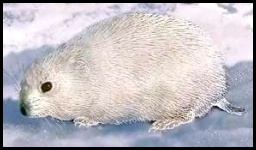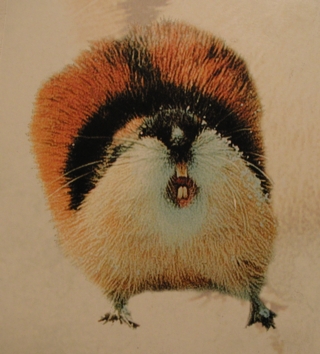"I say they're a bird," one friend said, "and he says they're a mammal, and this guy says they're a reptile."
"Yeah," said the third friend. "I think they're a type of salamander."
"They're not a salamander," I said, recalling my entry on salamanders. "But I do think they're reptiles. I think they're like mudskippers, with eyeballs on top of their heads."
"We want to know," said the second friend. "Because if we're not supposed to be like lemmings, we should at least know what they are."
"That's right," said the first friend.
"So there's an Apple subject for you," said the second friend. "Tell us what lemmings are."
As you wish.
- Lemmings are a vole, a type of rodent. They look like gray hamsters. In the winter, their fur turns white.

The lemming: an arctic rodent
(Photo from Corel CD-ROM, used at Elizabeth Viau's site on the tundra)
- They live on the tundra or in open grasslands, mainly in Alaska and northern Canada along the coast.
- They reproduce very quickly, betting that their sheer numbers will help them survive predators and the severe arctic weather. Lemming females can reproduce every 20 days, with litters of 6 to 9 babies each cycle. The young females become sexually mature when they're only one month old, so the number of lemmings can get to be exponentially high very fast.

In the winter, a lemming's fur turns white
(Photo from Arthropolis)
- They are food for a lot of predators, but because of their extreme rate of reproduction, they can get over-crowded fairly quickly. When they reach a crucial level of overcrowding, they will disperse, embarking on a migration to find more space.
- Sometimes that migration can get pretty frenzied, and since they often travel along the coastline or on the edge of embankments, sometimes the lemmings knocked each other into the ocean.
- Also if the food supply is scarce, lemmings may kill other lemmings to lessen the competition for food, or to create more food; that is, they may eat each other.
- Sometimes they head into the water, thinking they're crossing a river, but it turns out to be the ocean, and they drown.
- A little dense or even murderous they may be, but suicidal they are not.
- How then, did the lemmings-are-suicidal myth get started? Mainly from a 1958 Disney movie called White Wilderness.

Disney's White Wilderness was part of a series called True Life Adventures. White Wilderness is contained in this collection. - To make the movie, filmmakers bought some lemmings from Inuit children and then took the animals to landlocked Alberta, Canada. Lemmings do not live in Alberta, preferring colder climes that are not landlocked.
- The few lemmings were filmed on turntables from various angles. Those images were reproduced to give the illusion of a crowd of lemmings. They were then taken to a cliff overlooking a river and herded into the water -- some say "thrown off the cliff" -- while the cameras rolled.
- In the finished film, the voiceover says that the rodents are "carried along by an unreasoning hysteria," which results in the animals "casting themselves out bodily into space," when in fact people were flinging the lemmings into the water at the time.
- In other nature documentaries, filmmakers had difficulty capturing a lot of live lemmings on camera. More often, they were able to find lemmings that had swum out into the ocean, believing it to be a river, and drowning, or other lemmings being pushed off a cliff by their fellows during the mad dash to migrate.
- Many cartoons have also been drawn showing lemmings dashing headlong into the sea, including cartoons by none other than Gary Larson. I'm not allowed to reproduce that cartoon here, but you can look at it on this page.

This lemming says, "Don't believe the hype!"
(Photo from University of Wyoming's Population Ecology lecture notes)
- People have seen enough of these sorts of images to develop the notion that lemmings jump willy-nilly into the sea to drown themselves, when in fact, the lemmings are being murderous or careless or just dumb.
- (Hmm, in believing this Disney movie and other images we've been shown, are we not behaving like the mythical lemmings we have ourselves created?)
- In any case, though lemmings are not suicidal, the attributes they seem to have are not especially admirable. I'd advise against such similarly murderous, cannibalistic, careless, or stupid behavior.
Sources
Snopes.com, White Wilderness
Elizabeth Anne Viau, California State, The Tundra
Canadian Fauna, Lemming (Lemmus Lemmus)
Riley Woodford, Lemming Suicide Myth: Disney Film Faked Bogus Behavior, September 2003
April Fools' Science Fables, Lemming theory jumps in in the lake
IMDB, White Wilderness
Chris Clarke, "By Design," New Internationalist, Issue 308
Thanks for this - I always wondered why lemmings would be the only species to buck Darwin. Why would they want to commit mass hari kari if it was not in the interest of survival of the species? I thought maybe it might have something to do with overcrowding ... and now you have explained it nicely.
ReplyDeleteYeah, that didn't make sense to me, either. But if you really want to be puzzled by suicidal animal behavior, check out the entry on Moths to the Light. http://dailyapple.blogspot.com/2009/05/apple-384-moths-to-light.html
ReplyDeleteWonderful beat ! I wish to apprentice while you amend
ReplyDeleteyour web site, how can i subscribe for a blog site? The account helped me a acceptable deal.
I had been a little bit acquainted of this your broadcast
provided bright clear idea.부산달리기